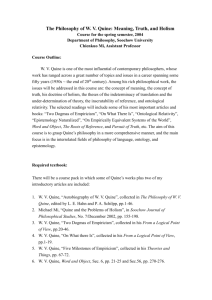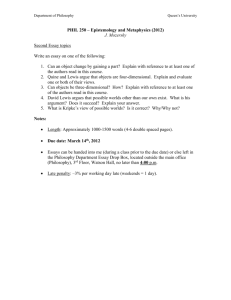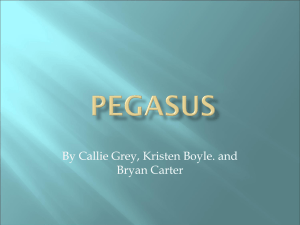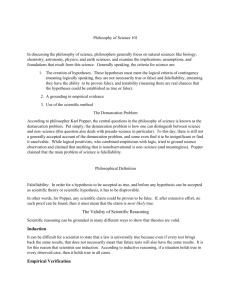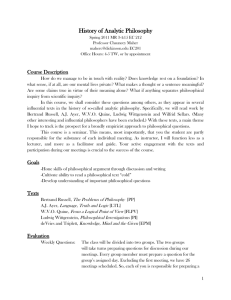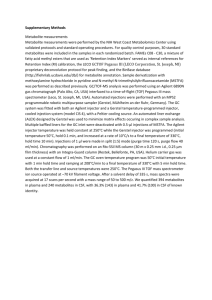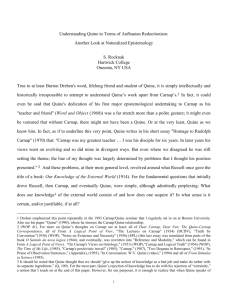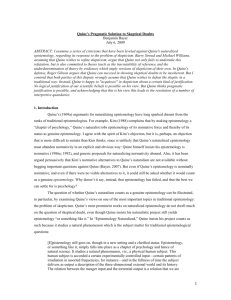Model Essay and Study Question Answers for “On What There Is”, by
advertisement
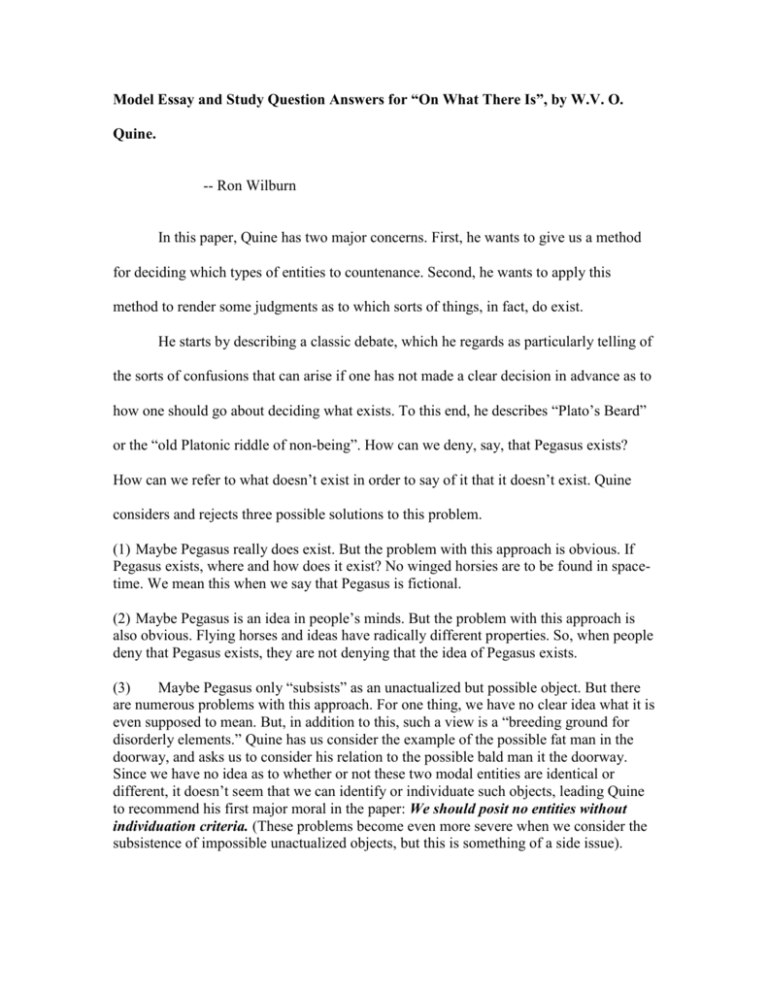
Model Essay and Study Question Answers for “On What There Is”, by W.V. O. Quine. -- Ron Wilburn In this paper, Quine has two major concerns. First, he wants to give us a method for deciding which types of entities to countenance. Second, he wants to apply this method to render some judgments as to which sorts of things, in fact, do exist. He starts by describing a classic debate, which he regards as particularly telling of the sorts of confusions that can arise if one has not made a clear decision in advance as to how one should go about deciding what exists. To this end, he describes “Plato’s Beard” or the “old Platonic riddle of non-being”. How can we deny, say, that Pegasus exists? How can we refer to what doesn’t exist in order to say of it that it doesn’t exist. Quine considers and rejects three possible solutions to this problem. (1) Maybe Pegasus really does exist. But the problem with this approach is obvious. If Pegasus exists, where and how does it exist? No winged horsies are to be found in spacetime. We mean this when we say that Pegasus is fictional. (2) Maybe Pegasus is an idea in people’s minds. But the problem with this approach is also obvious. Flying horses and ideas have radically different properties. So, when people deny that Pegasus exists, they are not denying that the idea of Pegasus exists. (3) Maybe Pegasus only “subsists” as an unactualized but possible object. But there are numerous problems with this approach. For one thing, we have no clear idea what it is even supposed to mean. But, in addition to this, such a view is a “breeding ground for disorderly elements.” Quine has us consider the example of the possible fat man in the doorway, and asks us to consider his relation to the possible bald man it the doorway. Since we have no idea as to whether or not these two modal entities are identical or different, it doesn’t seem that we can identify or individuate such objects, leading Quine to recommend his first major moral in the paper: We should posit no entities without individuation criteria. (These problems become even more severe when we consider the subsistence of impossible unactualized objects, but this is something of a side issue). Now Quine considers and endorses a fourth line of solution to the problem of “Plato’s Beard”. First, Quine recommends that we give up de re necessity and possibility and limit modalities to whole statements. Then, Quine recommends that we use Russell’s theory of singular descriptions to eliminate our reference to troubling entities. This method shows us how we can meaningfully use seeming names without supposing that the entities allegedly named exist. Definite descriptions only have meaning in the context of the sentences in which they occur. Thus, for example, 'The round square cupola on Berkeley College is pink' is properly explicated as 'Something is round and square and is a cupola on Berkeley College and is pink, and nothing else is round and square and a cupola on Berkeley College'. (Additional elements in this rendering specify the uniqueness of reference that is implicit in the phrase “the”.) The effect of this approach is to place the burden of reference on bound variables of quantification: e.g., 'something', 'nothing', and ‘everything’. And these words do not purport to be names at all; they refer to entities generally. As articulated above, this approach works only for definite descriptions. How do we extend it to seeming proper names and singular terms? Quine suggests that names like “Pegasus' can be easily understood as descriptive phrases. We have only to rephrase 'Pegasus' as a description, e.g., 'the winged horse that was captured by Bellerophon'. Generally, we can use this trivial device: “Pegasus has wings” means "There is an object that Pegasizes and this object has wings.” Quine suggests that Russell’s strategy is anticipated by the recognition that there is a difference between meaning and naming. Consider Frege's example: The phrase 'Evening Star' names a certain planet in outer space. ‘Morning Star’ names the same thing. But the two phrases have different meanings despite having the same reference. Similarly, Quine suggests the confusion of meaning with naming that McX makes supposes that without a reference “Pegasus” could not be meaningful. Of course, Quine notes, this might seem to threaten ontological complications of its own. For, doesn’t the distinction between meaning and reference commit us to the existence of meanings construed as entities? Quine claims not, since we do not have to posit meanings for expressions to be meaningful. We say certain expressions are meaningful and leave meaningful unanalyzed or else analyze it in terms of behavioral dispositions (sameness of meaning is understood as sameness of patterns of assent). This is simpler. Thus, Quine recommends that we shouldn’t posit meanings as entities. Now, Quine consider the problem of universals, in particular, thinks like attributes, relations, classes and numbers. Do these exist? Some say “yes.” Quine’s initial reaction to this is a note of procedural caution. For someone who believes in such entities, it is going to be trivially true that they exist. Why? Because such judgments will be rendered true by affirming linguistic conventions. Thus, Quine suggests that when we talk about such ontological issues, we can avoid some degree of confusion if we talk about language rather than about problematic candidate entities directly. Thus, Quine recommends that we avoid confusion in discussing ontology when we talk about whether or not words have referents rather than about whether or not attributes, for instance, exist. After urging such procedural caution, Quine addresses the issue directly: Should we take attributes and the like to exist? For Quine, “the words 'houses', 'roses', and 'sunsets' denote each individual entities which are houses and roses and sunsets, and the word 'red' or 'red object' denotes each of sundry individual entities which are red houses, red roses, red sunsets.” Consequently, Quine recommends that we should acknowledge the existence of characteristics as exemplified in individual instances, but not characteristics per se. 'Househood', 'rosehood', 'sunsethood' should thus perhaps be treated as ultimate and irreducible, or perhaps we can simply refer to the associated classes of objects and instances. In any case, McX cannot accuse us of positing Pegasis when we talk of objects pegasizing because pegasizing is not within the range of values of a bound variable. Thus, Quine recommends that we should not posit properties, attributes or relations as entities. Again, he thinks he can avoid positing such items because we do not need them in characterizing the physical or phenomenal world directly. Even though we may seem to invoke “Pegasizes” when we say, upon proper Russellian analysis, that Pegasus does not exist, we do thereby quantify over properties like “Pegasizes.” And Quine has already suggested that to be is to be the value of a bound variable of a scientific theory. Generally, Quine recommends that we should respect simplicity considerations and posit as little as possible. And what we do posit we should regard instrumentalistically. Just as the mathematical formalist retains seeming reference to mathematical entities, but construes these references as a mere play of insignificant notations. On this account, our hierarchy of reality is a layered affair. From the standpoint of a pure sensation language, physical bodies are convenient myths, and from the standpoint of both pure sensation language and physics, talk of numbers or sets is a convenient myth. But, in the final analysis, what we count as existing depends upon what we need in order to give the simplest and most systematic account possible with which to describe our evidence and our interactions with the world. “The quality of myth,” Quine writes, “is relative,” varying with our “interests and purposes.” Quine’s criteria of ontological commitment are thus ultimately pragmatic. Review Question and Model Answers: Question #1: McX argues as follows: 1. Suppose "Pegasus does not exist" is true. 2. If Pegasus does not exist, then "Pegasus" is meaningless -- it doesn't refer to anything. 3. If "Pegasus" is meaningless, then any sentence containing "Pegasus" is meaningless. 4. Thus any sentence containing "Pegasus" is meaningless. 5. Thus "Pegasus does not exist" is meaningless. 6. This contradicts our assumption in (1) that the sentence is true (true sentences can't be meaningless). 7. By reductio, Pegasus exists. Quine claims that when we press McX for an explanation of what "Pegasus" refers to, and whether it refers to some mass of flying horseflesh in some region of spacetime, McX agrees that there is no such object. So what does "Pegasus" refer to, according to Quine? Model Answer to Question #1: According to Quine, “Pegasus” doesn’t refer to anything. It has the surface form of a singular term, but really isn’t one. Rather, it is a syncategorimatic expression, possessing meaning only in the context of the sentences in which it occurs. The effect of this approach is to place the burden of reference on bound variables of quantification: e.g., 'something', 'nothing', and ‘everything’. And these words do not purport to be names at all; they refer to entities generally. Thus, one cannot refer to Pegasus. Rather, one can only assert that there is an object with the identifying properties commonly attributed to Pegasus. To deny that there is such an object, then, we need only negate this claim, so that we need not concede the existence of Pegasus as a precondition for denying his existence. Question #2: In what way does Quine treat proper names as disguised definite descriptions? Model Answer to Question #2: Quine suggests that names like “Pegasus' can be easily understood as descriptive phrases. We have only to rephrase 'Pegasus' as a description, e.g., 'the winged horse that was captured by Bellerophon'. Or, more automatically and trivially, we can just invent an appropriate predicate. For instance, instead of talking about Pegasus, we assert that an object exists which “Pegasizes,” where to pegasize is to have identifying properties of Pegasus. Then, we use the Russellian account of definite descriptions described in our answer to question #1 above. Question #3: Quine offers this criterion for reality: to be is to be the value of a bound variable. His interlocutor McX relies on this criterion to defend universals as follows: 1. 2. 3. 4. 5. There are red houses, red roses, and red sunsets. There is something they all have something in common. What they have in common is the attribute or property of redness or being red. Thus there is redness. (from 2, 3). By Quine’s Criterion for Reality, redness is real. Here, Quine denies premise (2) of McX's argument. But why? What is his argument? He claims that their redness is ultimate and irreducible. Yet do they really lack anything in common? Model Answer to Question #3: The first thing that Quine would respond in this regard is that, in talking about red objects, he needn’t refer to anything that all red objects have in common. Rather, he refers to various concrete items to which he ascribes various properties such as redness, and in these articulations there is no quantification over properties. The second thing that Quine would insist on in this regard is that there is nothing to be gained by taking our ontology a step further and consciously choosing to quantify over properties themselves in addition to concrete items. Why not? Because such a move would offer no explanatory advantages over our simply taking as primitive and unanalyzed the fact that, e.g., roses and fire engines and sunsets are all red. Quine’s idea here seems to be that as long as the exemplification relation between the likes of roses and redness remains unexplicated, we explain nothing by invoking redness as the thing that particular red things exemplify. Question #4: McX also makes this argument: 1. Predicates like "is red" are meaningful. 2. Thus there is something that "is red" means. 3. This meaning is the attribute redness, or something very like it. 4. Thus there is redness. (from 2,3). 5. By Quine's Criterion for Reality, redness is real. Here Quine denies the move from (1) to (2). What is his reasoning? Model Answer to Question #4: Even if Quine granted that meanings are “something very like” attributes, he would still reply that we can usefully talk about an expression or sentence being meaningful without acknowledging the existence of a meaning which it has. Whether we are talking about sentences having meanings or we are talking about sentences sharing meanings, Quine thinks we’d be better off talking about dispositions to behavior. Thus, for instance, for two sentences to share the same meaning is for them to do something like prompt assent and dissent under exactly the same background conditions. Quine’s reasoning here is probably along the following lines: We have to posit behavior anyway and positing meanings as additional entities doesn’t offer enough in the way of additional explanation to be worth its violation of simplicity considerations. Quine writes, “the explanatory value of special and irreducible intermediary entities called meanings is surely illusory.” Question #5: Quine seems quite concerned with limiting how many entities we have in our overall global ontology. Yet he seems at least tempted by realism about numbers, a position committed to at least infinity of abstract objects. Since X 0 (numbers) + X 0 (properties) = X 0 objects, allowing property realism adds no more entities to our ontology than we already have once we countenance numbers. In fact, X 0 is just the number of the natural numbers; there are more numbers than X 0. Indeed, there is no highest bound, no number of the numbers. So why isn't number realism dynamiting Quine's plans for a minimalist ontology? Model Answer to Question 5: Quine would probably say two things here. First, he would say that he wants to minimize not just the number of objects in our ontology, but also the number of types. Second, he would say that not all entities are equally respectable. One reason he rejects properties is that he can find no criteria for individuating them. Thus, he tries to make due with classes instead, since they can be easily be individuated by reference to membership. Numbers, he would probably say, can probably be either individuated in terms of their relational properties to other elements on the number line, or else reduced to classes, which can be individuated in the way described above.
